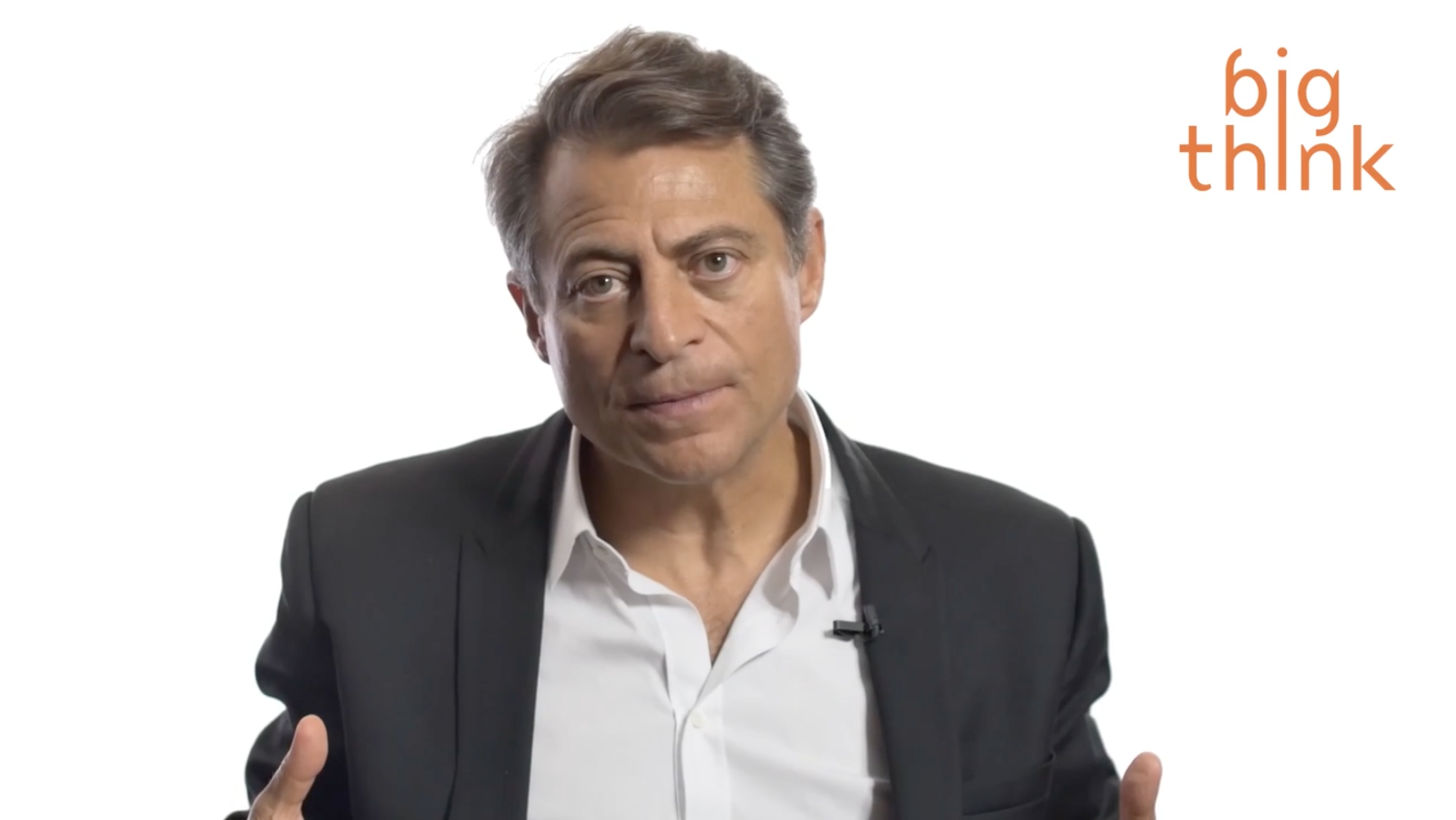Peter Diamandis believes that ideas need to do two things: be crazy, and know one another – you know, in a Biblical sense. Matt Ridley perhaps said it most provocatively in his book The Rational Optimist when he wrote that it’s vital for ideas to have sex. This is the sweet spot that true innovation calls home: someone has an idea or a problem, they share it with somebody else, and it gets built upon and made stronger with every new perspective that touches it.
Diamandis is the subject of Julian Guthrie’s brand-new book How to Make a Spaceship, and the chairman and CEO of the X PRIZE Foundation, a non-profit organization that creates public incentivized competitions that aim to accelerate technological breakthroughs for the benefit of humanity (the best known of which so far has been the Ansari X Prize for private space flight). So he knows a thing or two about driving innovation.
His thesis in the video above is a line that American aerospace engineer Burt Rutan once told him: the day before something is truly a breakthrough it’s a crazy idea. A company or a creative individual can find success in stability, but to really make an impact, leaps of innovation and rapid experimentation are required. And to get there, your craziest ideas need to see the light of day – even if they fail. Shoot for the moon, he says.
Diamandis outlines three tools to promote this kind of radical innovation. The first is to engage a sense of competition. When faced with a barrier that needs breaking, X PRIZE doesn’t offer a large sum of money and unlimited time to one team of geniuses to solve it. X PRIZE opens the floor to hundreds or even thousands of teams to compete for the solution, then it awards just one winner. Most of us know the phrase ‘think outside the box,’ but in Diamandis’ view it’s really more about shrinking the box down by applying constraints on time and resources, thereby forcing creative thinking.
The second is to create a very clear goal, then break the chain of command by crowdsourcing for ideas. What’s better than one senior company member’s big idea? One hundred of them, from all walks of life. Toy manufacturer LEGO has an open ideas platform where users can contribute new product and design ideas and gather votes to see them become a reality. Mashable has a round up of three case studies to look at here. Websites like GenuisRocket and Innocentive are worth a look.
The third tool involves turning your own internal cogs: Diamandis recommends reading as a fire-starter for innovative, far-out ideas. The Spirit of St. Louis, is what gave Diamandis the idea for the XPRIZE Foundation. Robert Heinlein’s The Man Who Sold the Moon gave him the idea for planetary resources and Google Lunar XPRIZE. It’s really another incarnation of ideas moving up against other ideas to create a spark. What is one flint-stone on its own? Nothing. But a flint-stone and a piece of steel? Now you’ve got fire.
Peter Diamandis is the subject of How to Make a Spaceship: A Band Of Renegades, An Epic Race, And The Birth Of Private Spaceflight.
Peter H. Diamandis: When I think of innovation and I teach this at Singularity University and Abundance 360, we focus on this at XPRIZE. Innovation is when an individual has an idea from reading a book or having a problematic experience and then takes that idea and shares it with somebody. And that person builds on the idea and shares it back and it’s a going back and forth. It comes from that building of ideas rapidly and rapid experimentation. Burt Rutan taught me something. He said the day before something is truly a breakthrough it’s a crazy idea. And so I ask CEOs all the time where inside your company are you trying crazy ideas? And if you’re not trying crazy ideas, if you’re trying sort of incremental ideas you’re stuck in incrementalism. You’re never going to innovate, you’re never going to expand. And so innovation really is this rapid experimentation of trying 100 ideas, 99 are failing and one works. And then you build on that one. You try over and over again. So, you know, the traditional way of solving a problem, a grand challenge, has been as a philanthropist or as a company you grab a chunk of money, you grab an innovator, you give it to them and say fix this problem. Very traditional but pretty linear.
What we do at the XPRIZE is we say here’s a chunk of money. I don’t care where you went to school, what you’ve done before, your race, creed or color, man or woman. It doesn’t matter. If you solve this problem you win. And so what we do in this sense is we’re running hundreds of experiments in parallel. And so while the Ansari XPRIZE had 26 teams from seven countries, some of our competitions have thousands of teams that have registered. And it’s sort of this Darwinian competition going on where crazy ideas get a chance to see the sunlight and get experimented with. And you only pay the winner. And so it’s really a wonderfully new and fresh mechanism of innovation.
The concept that we use at the XPRIZE and I use a lot is crowdsourcing. And it’s really being clear about what your goal is. If you don’t have a goal you’ll miss it every time. And so if you’re brainstorming or you’re trying to innovate around what, you know. You might say listen, we want a million dollars’ worth of revenue and we want it to be very specifically in this area and we want whatever it might be – we want to sell books, we want to do whatever. You have to define very clearly what you want to achieve with a clear objective goal. And then if you’re able to share that objective clear goal with a thousand people you’ll get a hundred different ideas. And then you let them compete each other out. One of the difficulties and I write about this in my last book Bold is that most people when they’re trying to solve a problem say you’ve got all the money you want, all the time you want, all the resources you want. And people are lazy. They’ll use all the time, all the money, all the resources. And you’ll get very incremental progress. If you really want true innovation, you want something that’s very different you need to constrain the problem, hyper constrain the problem. You say you don’t have a year and a million dollars. You’ve got a week and a thousand dollars. Fix the problem. And most people will say it can’t be done. But the people that accept the challenge have to throw the old way of doing it out the door and try crazy ideas. And occasionally the crazy idea will work. So when you’re looking to solve a big problem don’t think out of the box. Think in a very small box.
And that’s what XPRIZE’s do. They introduce very significant constraints of here’s the amount of prize money. The prize is over this amount of time and this is a really difficult problem. And it forces people to come up with nontraditional approaches because that’s what you want. You don’t want the same old shit being used, right. You want to be able to like actually get people to try new approaches. And the constraints is what forces people to let go of what they’re comfortable with and try something that ultimately is crazy. And again like Burt Rutan taught me the day before something is truly a breakthrough it’s a crazy idea. So let me mention something else. I have gotten most of my best ideas from reading books. Books are for me a conversation with the author. It’s a chance to explore an idea, hear their ideas and iterate on ideas, this conversation. For me for example The Spirit of St. Louis, Lindberg’s book on his journey was what gave me the idea for the XPRIZE Foundation. Robert Heinlein’s The Man Who Sold The Moon book that gave me the idea for planetary resources and Google Lunar XPRIZE.
And The Singularity is Near by Ray Kurzweil gave me the idea for starting Singularity University. So one of my greatest hopes is that Julian Guthrie’s book How to Make a Spaceship will be an inspiration for entrepreneurs to go and create their next great journey, right. It’s a story of having a big dream and hitting roadblock after roadblock after roadblock and overcoming it because it’s your heart and your soul. So what I say to people is if you have a kid in high school or in college it’s a great book to inspire them. If you’re an entrepreneur read it to get inspiration for yourself. I’m so proud that Richard Branson wrote the foreword and Stephen Hawking wrote the afterward. And it’s a book I hope will really inspire thousands of moon shots out there.






